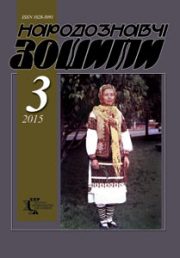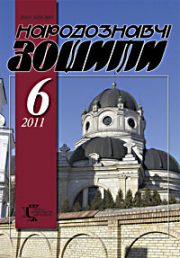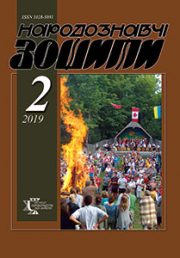The Ethnology Notebooks. 2021. № 6 (162), 1349—1355
UDK 94(477.83/.86-22)”19″:37.011.3-051
DOI https://doi.org/10.15407/nz2021.06.1349
SOVIET DAILY OCCURRENCE THROUGH THE PRISM OF LOCALITY
HODOVANSKA Oksana
- ORCID ID: https://orcid.org/0000-0002-8297-2414
- Candidate of Historical Sciences (= Ph.D. in history),
- Senior Research Fellow, Department of Social Anthropology
- Institute of Ethnology of the National Academy of Sciences of Ukraine,
- 15, Svobody Avenue, 79000, Lviv, Ukraine,
- Department of History of Ukraine, Museum Studies and Cultural Heritage,
- Lviv Polytechnic National University,
- 12, Bandera street, 79013, Lviv, Ukraine,
- Contacts: e-mail: oksana.m.hodovanska@lpnu.ua
Abstract. Having regard to the rethinking of the Ukrainian Soviet period its territorial localization is essential.
The purpose of the proposed survey is to determine the influence of «local» properties on Soviet everyday life.
To implement it, the following tasks are set — to identify local features and analyze their significance in the study.
The article deals with the daily life of teachers, its comprehension and evaluation by teachers themselves and makes allowances for the macro-historical and micro-historical events of that time considering their interrelations and interaction with teachers’ everyday life.
Territorial borders are delineated by the so-called Eastern Halychyna, which covered the Ukrainian ethnic lands. Today it is entirely Lviv, Ternopil and Ivano-Frankivsk regions.
The study of the sphere of human everyday life as well as the in-depth interest in the Soviet era provides the using of various methods and methodological approaches involving the widest possible source base.
Oral history as a source and a method of representing the anthropological dimension of historical reconstructions plays a key role in the study of Soviet everyday life.
The local history of Soviet daily occurrence is a good material for studying the totalitarian past of Ukraine and redefining the past which is «trying to catch up».
The territorial localization of the Soviet experience makes it possible to lay emphasis on the «Sovietness» in its details and to assert its influence on the everyday life of Soviet teachers.
Keywords: daily occurrence, rural areas, Eastern Halychyna, teachers, Soviet period.
Received 3.10.2021
REFERENCES
- Yekelchyk, S. (2018). Everyday Stalinism: Kyiv and Kyiv after the Great War. Kyiv: Laurus [in Ukrainian].
- Yeremeeva, K. (2018). To beat with satire: the magazine «pepper» in the socio-cultural environment of Soviet Ukraine. Kharkiv: Rarities of Ukraine [in Ukrainian].
- Bykov, A., & Gubkina, I. (2019). Soviet Modernism. Brutalism. Post-Modernism. Buildings and Structures in Ukraine 1955—1991. Kyiv: Osnovy.
- Plokhii, S. (2019). Chernobyl. History of the nuclear catastrophe. Kharkiv: Folio [in Ukrainian].
- Kaganov, Y.O. (2019). Construction of the «Soviet man» (1953—1991): Ukrainian version. Zaporozhye: Inter-M [in Ukrainian].
- Kuzina, K. «Chronotype of the Soviet» review of the scientific-theoretical seminar from the series «Everyday life: visions and meanings» (April 15—16, 2021). Retrieved from: https://uamoderna.com/event/xronotop-radyanskogo-oglyad-naukovo-praktichnogo-seminaru-iz-cziklu-povsyakdennya-vizii-ta-smisli-(15—16-kvitnya-2021-r) (Last accessed: 21.09.2021); Soviet past. (re) understanding of history. Competition of student youth projects in 2019—2020 academic year. Retrieved from: https://competition.novadoba.org.ua/text-1.php і https://competition.novadoba.org.ua/ (Last accessed: 11.08.2021) [in Ukrainian].
- Kolyastruk, O., & Kulchytsky, S.V. (Ed.). (2009). Theoretical and methodological aspects of the study of everyday life. Essays of everyday life of Soviet Ukraine in the NEP era (1921—1928) (Part 1, pp. 8—17). Kyiv: Institute of History of Ukraine; National Academy of Sciences of Ukraine. Retrieved from: https://shron2.chtyvo.org.ua/Zbirnyk_statei/Narysy_povsiakdennoho_zhyttia_radianskoi_Ukrainy_v_dobu_nepu_1921-1928_rr_Chastyna_1.pdf? (Last accessed: 11.08.2021) [in Ukrainian].
- Kis, O. Telling the Untold: Representations of Ethnic and Regional Identities in Ukrainian Women’s Autobiographies. (download. doc file). The Ukrainian coordinator of Women`s Memory Project. Retrieved from: http://www.womensmemory.net/english/news.asp (Last accessed: 07.02.2019).
- State Archives of Lviv region (DALO). F. Р—163. Op. 4. Spr. 50. Arc. 33. Reports on the implementation of the law on general compulsory education [in Ukrainian].
- Hnatyuk, O. (2015). Courage and fear. Kyiv: Dukh i Litera [in Ukrainian].
- Bos, Pascale, Grinchenko, H., Kobchenko, K., & Kis, O. (Eds.). (2015). Gender and the Holocaust. Women of Central and Eastern Europe in the Second World War: gender specifics of experience in times of extreme violence (Pр. 209—218). Kyiv: Art Books [in Ukrainian].
- Kis, O. (2008). Reception of Soviet power and independence in autobiographical stories of Ukrainian women based on the materials of the project «Ukraine of the XX century in the memory of women». East-West: historical and cultural collection: Oral history in modern socio-humanitarian studies: theory and practice of research (Issue 11—12, pp. 283—307) [in Ukrainian].
- Yekelchyk, S. (2008). The Empire of Memory. Russian-Ukrainian relations in the Soviet historical imagination. Kyiv: Chasopys Krytyka [in Ukrainian].
- Styazhkina, О. (2013). Man in the Soviet province: mastering (from) the language. Donetsk: DonNU [in Ukrainian].
- Hodovanska, O., Smalenchuk, A., & Kondratyuk, O. (Ed.). (2018). «Post-war smoke» of Soviet repression: based on oral stories of rural teachers in Halychyna. Mass Repression in the USSR in Historical Research and Collective Memory (Pp. 453—468). Minsk: Publisher Zmitser Kolas [in Ukrainian].
- Pliusch, L. (2002). In the masquerade of history. Testimony. Kyiv: Fakt [in Ukrainian].
- Kakovsky, K.H. (Ed.). (1982). City and village: overcoming significant differences. Kyiv: Politvydav Ukrainy [in Ukrainian].
- Kotenko, J. (2016). Local identity as a condition for the development of united territorial communities (training module). Kyiv: Legal Status. Retrieved from: https://decentralization.gov.ua/uploads/library/file/79/Lokalnaidentuchnist.pdf (Last accessed: 11.08.2021) [in Ukrainian].







